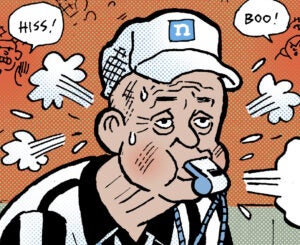AppNexus CEO Brian O’Kelley has been waiting 10 years for ad tech to become transparent.
Less than a week after Rubicon Project slashed its take rate in half, to 10% to 12%, by doing away with buy-side fees, AppNexus said its fees are even lower. The company revealed it charges an 8.5% average to the sellers on its platform.
“I would love to understand why Rubicon got away as a public company taking nondisclosed buy-side fees for two years,” O’Kelley told AdExchanger after AppNexus’ annual summit in New York City on Wednesday. “We didn’t, but they were worth a billion dollars. How is that possible?”
This year, AppNexus adopted a strategy – supply path optimization (SPO) – that will allow it to benefit from having a low take rate. The AppNexus DSP routes demand to the lowest-cost path to supply, which favors its own exchange. If the AppNexus SSP offers the best integration and lowest spend compared to competing SSPs, the DSP will buy only through AppNexus.
Developing a supply path optimization logic that favors your own company sounds like a conflict of interest.
To head off those concerns, AppNexus is providing its clients with data proving why its own exchange offers the best path to supply. “We have to be transparent because we could favor our own integrations,” O’Kelley said. Other clients ask to review supply path optimization decisions.
On the sell side, O’Kelley said AppNexus doesn’t always pick itself as the preferred path to supply. But he will urge its publisher team to lower rates with a publisher if the DSP doesn’t pick AppNexus.
O’Kelley talked to AdExchanger about AppNexus’ strategy of charging the lowest fees on the supply side, and then routing media spend to the exchange with the lowest fees.
AdExchanger: If header bidding was a level-the-playing-field moment, is supply path optimization a winners-and-losers moment?
BRIAN O’KELLEY: Yes.
Elaborate.
You may get turned off if you are not able to create value or compete and a single-digit rev share. If a buyer sees there are three prices for the exact same thing, they will want the most cost-effective path. [Exchanges and SSPs] may have to compress their prices, or it could be worse than that.
I’m not sure there is any other exchange or SSP operating at single-digit rev shares. We are significantly more cost-effective because we are significantly bigger and can operate at scale.
Do you look at anything else besides price when doing supply path optimization?
Access to inventory. Whether the header integration is as good. Are our line items in the exact same spot as the DFP waterfall? Do we see every placement and every size? We would never preference the supply to [an exchange] that doesn’t have a header integration.
Is the AppNexus DSP now prioritizing the AppNexus SSP because you have those single-digit fees?
If I look at our header integration and it’s more expensive or not as good as someone else’s, we will buy through someone else’s.
But we will use it as a data point to talk to our publisher team and say, “Why isn’t ours as good? We need to fix this.”
That’s one reason our rates are so low. Our buy-side team, which is completely separate from the sell-side team, is holding them accountable for being the best.
Do publisher clients let you share your take rate information with buy-side clients?
We told you [for the story on buy-side fees]. And we are going to each of our publishers and asking them for permission to share on an ongoing basis.
All our new contracts allow us to share the fee structure with buyers. Right now, a little over half our contracts allow us to disclose fees. We have sent contract revisions to all of our US publishers, and plan to get the ability to always show full fees to buyers, which I don’t think anyone else does.
If I’m a publisher working with AppNexus, but AppNexus decides to supply path optimize to another SSP, why continue the relationship?
Because we are just one DSP. There are a lot of other bidders.
Is the AppNexus pitch to publishers, “We have unique demand, and we bid on our own publishers more than third parties”?
Not really. If we didn’t bring any unique demand, we’d still sign publishers. And in certain markets we are not doing supply path optimization, like video, and we are still selling really high-quality video supply. A lot of the publishers we signed before we started doing SPO.
Google would take a lot of flak if it did supply path optimization.
Unless they want to do the same thing we’ve done, which is demonstrate through data that their fees are lower.
If someone else says they are going to cut the rate card on a publisher below AppNexus’, we should SPO to the lower rate card. It’s going to be a price war. If Google wants to compete on rates, let’s do it. So far, Google has not been interested in doing that.
Google is quietly allocating demand toward AdX, but without making any rationale to the buyer as to why. It’s bad for the buyer. It’s bad for the publisher. It’s great for Google.
What do you mean when you say Google is allocating demand to AdX without justifying it to DoubleClick Bid Manager (DBM) buyer?
Most DBM buyers we talk to say more than half of their spend goes to AdX when they use DBM.
Why do you think that happens? Maybe Google has better cookie syncing?
We have 95% or 100% cookie sync. We don’t see it.
We have more unique supply than AdX does in most markets. We have major publishers like LinkedIn and Microsoft and Axel Springer and Schibsted. Since YouTube is not part of AdX anymore, the only unique O&O inventory is Google Finance. Everything else is commodity.
Why does [AdX] get more spend? It’s a fair question. If Google’s not doing SPO – and I’m not sure they should, given their market position – I’d love to know their rationale.
How do you think other DSPs and SSPs feel about AppNexus doing supply path optimization?
As a DSP, if they are making bad supply decisions, we’ll outperform them. When people switch from DBM to our DSP, they see significantly better access to inventory, and lower prices and better outcomes. I’m glad Google is doing that because it means we outperform then. You always want your competitor to make bad decisions.
As an SSP, obviously Rubicon would love it if we spend more with them. As we’ve seen in the past few weeks, it’s pretty clear why every time we ran the analysis, their supply was more expensive and we turned it off. We assumed it was auction logic. It turned out it was nondisclosed buy-side fees.
I don’t see how they can complain about [SPO] on any data-driven rationale.
You say you were founded on a low-fee strategy. Why has it been taking so long for that strategy to gain traction?
There are a lot of folks who aren’t strongly incentivized to find the lowest-cost, most transparent path to buying things. There are trading deals with backroom agreements. There are nondisclosed business models.
All kinds of things are being done that may not be in someone’s commercial best interest to do something that is in their client’s best interest.
This interview has been condensed and edited.














